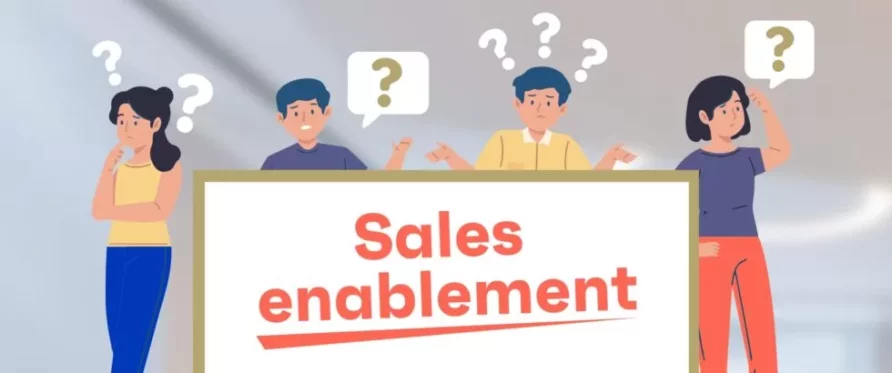A good relationship with Sales, we help you.
What is sales enablement? Strategies, solutions and process

Welcome to the strategies, solutions, and process of sales enablement! You might be wondering what sales enablement is and why is it so important for businesses. Here, you will learn all about it, step-by-step. Sales enablement comes down to selling processes and “closing the deal.”
Most sales teams are challenged when it is time to turn their prospects into customers. You cannot determine which strategy or what content to use. Without having a concrete plan in mind, you spend a lot of time following random selling tactics.
Sales enablement provides the answer; a concrete methodology, supplying the sales team with content and tools to help them closing the deal. In other words, the complex B2B selling process made easy!
Jump to
What is sales enablement?
Sales enablement is the process of providing the sales organization the information (data and insights), content and tools that help Sales adding value in every customer interaction and selling more effectively & efficiently.
Forrester defines sales enablement as a “strategic, ongoing process that equips all client-facing employees with the ability to consistently and systematically have a valuable conversation with the right set of customer stakeholders at each stage of the customer’s problem-solving life cycle to optimise the return of investment of the selling system” (Didner, 2019).

What are the benefits?
According to a survey by Gartner, 77% of the B2B buyers found their latest purchase to be overly complex or difficult (see Figure 2.) With that in mind, the biggest challenge of B2B selling today is not actually selling but that customers are struggling to buy.
Sales enablement is part of the solution. Not only does sales enablement add value to every customer interaction, but it also drives sales effectiveness and efficiency. The better Sales is equipped to sell, the easier it becomes for the business buyer to buy.

Why does sales enablement help my business?
Here are 4 reasons why your business needs a sales enablement methodology:
- As a B2B buyer, when it comes to complex buying decisions, it is quite important to read relevant and insightful information before deciding. Sales enablement adds value to every customer interaction, as it provides prospective B2B customers with the content that they need to evaluate all this information.
- The methodology of sales enablement allows salespeople to speak on the same level as their prospective B2B customers. Being at the same level with prospects is quite important; with sales enablement, the sales team can provide the right piece of content that answers the prospect’s question. This is more important today as many companies are adopting an account-based marketing and sales programme.
- Sales enablement makes selling more efficient, as it provides a concrete methodology. That means that it can always be optimized to drive better results.
- Sales enablement makes selling more effective because the process is customer-centric, which eventually drives sales.
Need help with sales enablement?
What is a sales enablement framework?
The sales enablement framework is based on the B2B buyer journey. The sales and the buyer journey are two parallel processes. As can be seen on figure 3, B2B buyers go through several phases when trying to make difficult buying decisions; starting from discovering a particular problem (trigger & interest phase), researching workable solutions to this problem (research & learn phase). After gathering information, they assess all the information (evaluate & assess phase), and eventually they make buying decisions (justify & purchase phase).
At the same time, sales enablement allows Sales to provide the right content to attract the buyers and direct them to the purchase. The sales enablement framework helps you understand how to make a sales enablement plan. It involves customer-facing content, sales enablement content, sales enablement training & coaching, and sales enablement technology. All these elements are essential for driving sales enablement results.
Customer-facing content refers to the content that people face when searching a solution to their business needs. On the other hand, sales enablement content is internal content. It is content that is specifically designed by the marketing team to help Sales prepare for interactions with prospects and customers. This content can be derived from any stage of the buyer journey.
Proper training and coaching are required to provide salespeople with the skills to apply the sales enablement methodology in practice. The right technology is also an internal process, and it facilitates Sales reaching out to B2B prospects.

What are the top 3 elements of a sales enablement plan?
Every sales enablement plan needs to include 3 elements to be successful: content, training/coaching, and technology.

- Content: The sales enablement methodology is based on content. Therefore, content is the first essential element of a sales enablement plan. Content pieces can vary, from case studies and customer testimonials to playbooks and sales sequences. The goal of the content is to add value in every customer interaction. By providing the right content, Sales can help B2B buyers get deeper insights and convince them towards one decision or another.
- Training/coaching: The training/coaching element is particularly important and refers to a combination of things. Sales need to have industry knowledge and follow a methodical approach, to understand what to do and why. Additionally, you need to have the right skills to follow this methodology, such as storytelling and active listening. Lastly, you might need to onboard new colleagues to support them in this process.
- Technology: Technology is essential to facilitate the selling process. The sales technology is currently huge. The sales enablement tools are discussed in detail below.
Software tools
- What is a sales enablement platform?
Gartner defines sales enablement platforms (SEPs) as tools that unite sales enablement functions and customer-facing sales execution. They feature native capabilities for sales content, sales training, and coaching.
- The sales technology landscape
The technology that is used for sales is growing rapidly (see figure 5). There is a variety of tools that support different purposes; engagement, productivity & enablement, sales intelligence, pipeline & analytics, and people management. Big companies such as Hubspot and Outreach offer such software to facilitate the sales processes. Sales enablement software is only a part of the sales technology, and it should be chosen based on your organizations’ needs and goals.

- Sales enablement VS CRM: What is the difference?
Many people tend to confuse sales enablement with customer relationship management (CRM). These two terms have different meanings and purposes. Sales enablement is a strategic approach, which provides tools and resources to salespeople to help them make more deals. CRM on the other hand, refers mostly to the technology for managing all the relationships and interactions with customers and potential customers.
- How to use LinkedIn in my Sales enablement programme?
LinkedIn is a powerful tool that helps sales representatives finding and reaching their target audience. One of the great advantages of LinkedIn, is the ability to see detailed information on other professionals’ profiles.
For example, by looking at profile headlines, salespeople can see the job titles and based on this you can determine if they are the right target audience. Also, the “About” section shows insightful information about a person’s professional interests. All this information can be used by sales representatives to send personalised messages and start a conversation.
LinkedIn Sales Navigator is another tool used by many sales professionals. It is a platform that helps Sales find prospects and build relationships. It includes tools such as advanced lead and company search, alerts on your sales leads and accounts, and the ability to create custom lists.
- How does sales enablement relate to marketing automation technology?
Normally, sales enablement is used by salespeople whereas marketing automation is used by marketers. However, for the success of a sales enablement programme, it is quite important that the two teams are fully aligned.
Some teams want to merge marketing automation tools, such as Marketo or Pardot, with the sales software tools that they are using in their organization. Linking the marketing and sales systems could be beneficial for the sales process, as the qualified leads or qualified accounts would be automatically passed to sales. Consequently, the marketing and sales systems alignment would allow Sales to accelerate the account engagement.
How to create a sales enablement plan?
The creation of a sales enablement plan is not simple nor easy, as there are several things that need to be considered:
- Firstly, setting the plan’s objectives and understanding the customers’ struggles are crucial.
- Secondly, talking to sales representatives is quite helpful as it provides a better understanding on the challenges of the sales processes.
- Lastly, organizing the internal sales enablement content as well as finding the right tools and training for the sales team is essential.
Because of the complexity of the process, the best way to create a concrete plan with success potential is to get help from sales enablement experts.
Need help with sales enablement?
A good relationship with Sales, we help you.
What is good sales enablement content?
- How does content marketing fit into sales enablement?
Content marketing is directly related to sales enablement, as sales enablement is the process of providing the sales team with the right resources to close more or better deals. The content can be of two types: customer facing content and sales enablement content. Customer-facing content is content that people want and need before making a buying decision. Sales enablement content is the content that is specifically designed to help Sales prepare for interactions with prospects and customers.
- What are the best types of sales enablement content?
Sales enablement content can relate to any stage of the buyer journey. Some valuable content pieces for sales enablement are rich blog posts, persuasive case studies, eBooks, sales playbook, white papers, testimonials, and sales battlecards.
- What are sales sequences?
A sales sequence is a scheduled series of touchpoints that salespeople use to improve their sales efforts. Examples of such touchpoints are emails, phone calls, social messages, and other ways of communication.
It is quite important to use sales sequences during the sales enablement process, as it defines the messaging strategy. You cannot approach different personas using the same messaging strategy or channels.
The length of the sequence also varies depending on the persona; for example, for high touch personas, it is recommended to have 12-15 touches over 4+ weeks, while for low touch personas it is recommended to have 8-12 touches over 3-4 weeks. High touch personas are all the people who play a role in the decision making of a product, while low touch personas are influencers of such decisions, with less influence compared to high touch personas.

How to make the sales enablement training effective?
It is important for businesses to take some time to create a sales enablement training plan. Different skills are required for different sales functions; Inside Sales need high level of product knowledge and strong verbal communications skills, as well as research and presentation skills.
Outside Sales on the other hand, need to conduct needs analysis, offering recommendations and solutions and preparing proposals. Effective training needs to create long-term change in the behavior of salespeople, leading to positive results (Didner, 2019). Optimization of the training programme is also important; don’t forget that sales enablement is an ongoing process and therefore requires ongoing optimization.
What are best practices?
A nice example of case study is the sales enablement campaign of SPOTONVISION for Indeed. The goal of this campaign was to provide the decision makers of Indeed’s targeted accounts with the added value of partnering up with them. For that purpose, qualified meetings for Sales were created and personalised content was used to show that Indeed has access to valuable data for companies. Expanding the target account list is one of the outcomes of this successful campaign. Read how Indeed reached their goals with SPOTONVISION!
Defining responsibilities
As already discussed, sales enablement requires content. It is very important that the sales and marketing teams work together during this process. It is quite essential to keep the teams aligned and up to date from both sides. The sales team should inform the marketing team about the “pains” of the B2B buyers, and the marketing team should create content with the aim to provide solutions to the buyers’ struggles.
What are the main challenges for sales enablement in B2B?
There are several challenges when it comes to creating and executing a sales enablement plan. Very often, sales enablement managers find it hard to select the right tools. Not only do you need to find the right technology for sales enablement, additionally, content selection can be a challenge. Choosing the right pieces of content to convert prospects into customers can be difficult. Finally, it is very important to have clear communication between teams in order to listen to the needs of the buyers and create content specifically for these needs.
The key to a successful B2B sales enablement programme
Creating a sales enablement programme is not an easy task. The way to have success potential is to ask the right people.
Need help with sales enablement?
A good relationship with Sales, we help you.
Share this article
Related insights
Grow your B2B Marketing knowledge
Subscribe to keep up with our latest B2B Marketing updates and exclusive events. Straight to your inbox, once a month.




